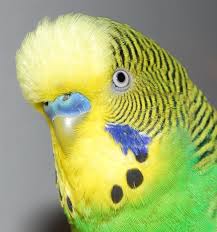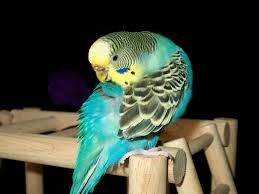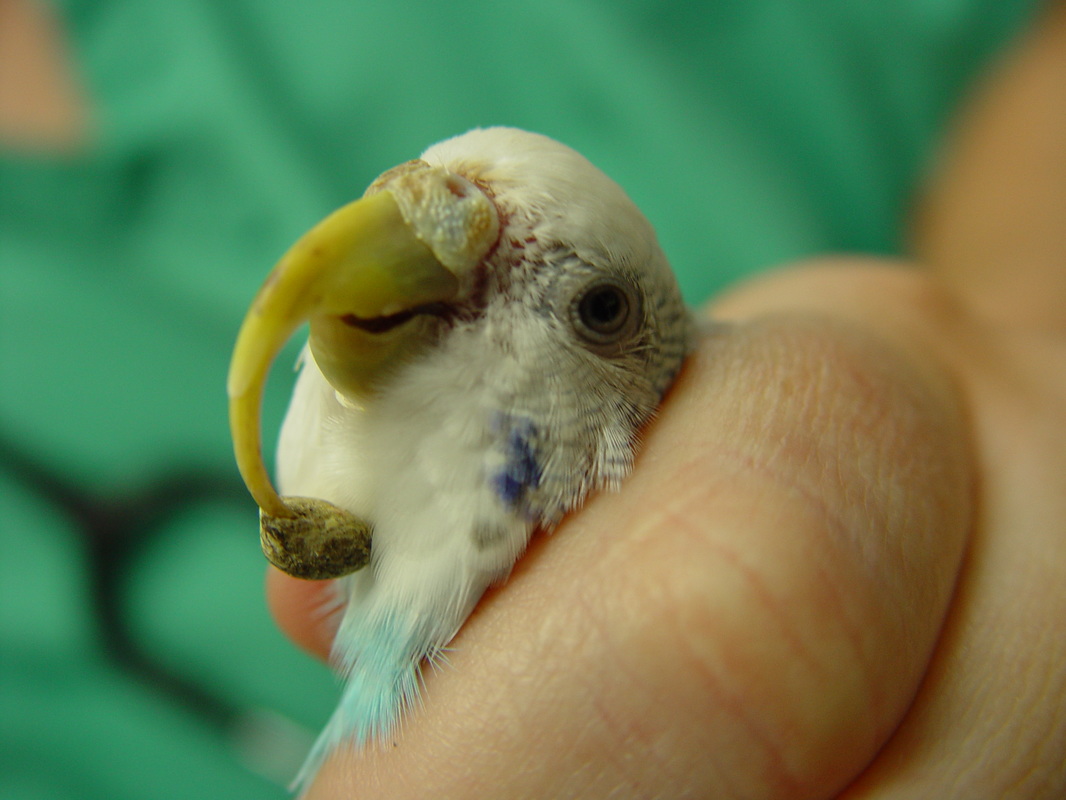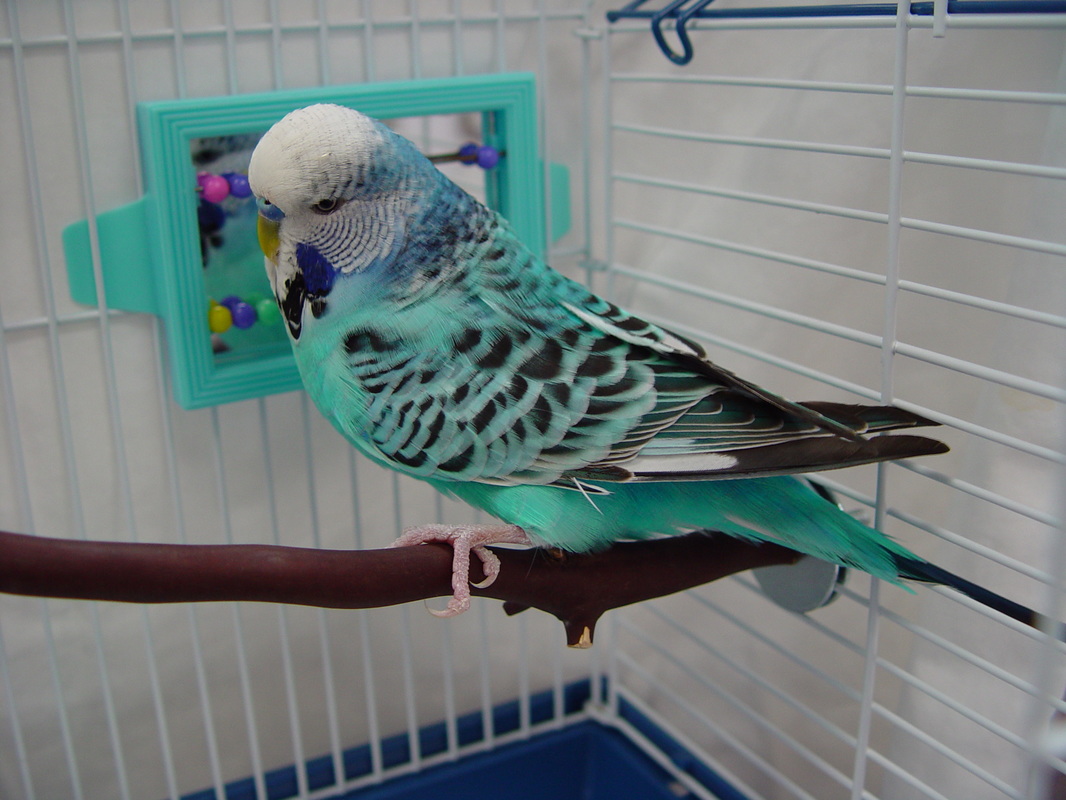Budgie Care (Parakeet)
Erica Mede, CVT
Natural History
These playful little parrots are an ideal companion for apartment dwellers and those that love parrots but can not handle the loud screams of larger ones. Budgies typically live 8-15 years but the budgerigar will make a welcome addition with their chirping, singing, and mimicing. Budgies are often referred to as common pet parakeets and shell parakeets. The budgies in this care sheet are specifically the Melopsittacus undulatus and come from the drier open scrub and grasslands of Australia. These birds are naturally social and found in small flocks always on the move searching for the best food. Unlike most parrots, budgies are sexually dimorphic after 6 months of age with males having royal blue ceres (the fleshy part by their nostrils) and females will have brown or pale brown to white ceres. Contrary to popular belief, pink ceres are immature parakeets not necessarily females. Male pictured on the left, female on the right.
These playful little parrots are an ideal companion for apartment dwellers and those that love parrots but can not handle the loud screams of larger ones. Budgies typically live 8-15 years but the budgerigar will make a welcome addition with their chirping, singing, and mimicing. Budgies are often referred to as common pet parakeets and shell parakeets. The budgies in this care sheet are specifically the Melopsittacus undulatus and come from the drier open scrub and grasslands of Australia. These birds are naturally social and found in small flocks always on the move searching for the best food. Unlike most parrots, budgies are sexually dimorphic after 6 months of age with males having royal blue ceres (the fleshy part by their nostrils) and females will have brown or pale brown to white ceres. Contrary to popular belief, pink ceres are immature parakeets not necessarily females. Male pictured on the left, female on the right.
Home Safety
There are many things in the average home that pet parrots encounter that can be harmful and even deadly. Some concerns are obvious such as open flames but others such as an air freshener can be easily overlooked.
Diet and Feeding
Budgies are herbivores, more specifically they are granivores (seed and grain eaters). In the wild, these birds primarily consume spinifex seeds, various grass seeds, and ripening seeds from wheat and other agricultural products. Budgies have an unique quirk about their food dishes. They will not eat food out of a covered food dish! Due to their natural propensity to eat the seeds of grasses off the ground it is recommended to offer new foods, such as pelleted diets, into their routine by placing them on the floor of the cage and/or a mirror on the floor of the cage. The reason for the mirror is simple, if a budgie sees another budgie eating, it will eat that food more readily although a full conversion will still take time. It is natural for these birds to gorge themselves on a particularly delicious treat or after they have been adopted from a rescue. This is a natural behavior.
The ideal budgie diet consists of:
75-100% Pelleted Diet
15-25% Natural Diet
10% Treats
Remember, all conversions to different diets must be made gradually and care must be taken to monitor food intake as well as weight. Budgies are incredibly prone to obesity as well as fatty liver disease (hepatic lipidosis) and food consumption should be monitored and exercise encouraged with regular social interaction and activities.
Unsafe Foods:
Enclosure
With parrots, the bigger the enclosure the better! These birds are very active in the wild and need to have ways to relieve their natural energy in the home. The enclosure needs to be wider than it is tall. Although these birds enjoy climbing the bars it is more important that they can flutter to each side of the enclosure. Bars should be spaced no more than half an inch apart. It is incredibly important to make sure that the cage is not constructed of any form of zinc, lead, or galvanized metal as this can cause life threatening toxicity! Unfortunately, most of the enclosures sold in pet stores for budgies are inappropriately small for this species.
Perches should be placed at various heights throughout the enclosure with the softer perch being the highest as this is where most parrots prefer to sleep. Toys should consist of soft wood tree branches, rope toys, cardboard toys, wooden toys, and leather (vegetable tanned only!). Anything that can be “groomed” with their beaks are immediately appreciated as budgies love to preen! These birds are chewers, and cannot help themselves, so perches and toys will frequently need to be replaced and should be inspected daily for wear and potential dangers. Shredable toys are ideal as well. Females, especially egg laying females, should not be offered mirrors or bells which often inadvertently stimulates their desire to breed and continue laying eggs.
Lighting
These birds, like most parrots, are early risers! Once the sun comes up they are ready to go and will call out to their flock first thing in the morning! It is important that budgie rooms are well lit and offered natural sun light as well. However, never place a bird cage directly in front of a window. During the day the sun through the window can easily over heat a parrot. Ideally, the light cycle should be 12 hours of light and 12 hours of darkness. In reproductive females, this time may have to be decreased to 8-10 hours of daylight depending on the severity of the hormonal issues. Consult your veterinarian or behaviorist before making changes to the light cycle. There have been several studies that illustrate the benefits of parrots, especially female parrots, receiving UVB lighting as well.
Behavior
These birds are very vocal and love to be the center of attention! Generally, in the wild they are vocal while in their flock which explains why at home they can be louder especially when “flock members” are coming in the door. One thing to remember is that parrots will match the decibel level of their environment which means that the louder the household is the louder the bird will be. Being able to identify their vocalizations can help an owner understand what their bird is trying to communicate:
Most owners will purchase these birds as slightly younger birds. At this stage they are incredibly affectionate and loving. As these birds start to reach maturity (past 6 months old) their behavior tends to change and they will bond closely with one another. If they are housed alone, this is when they will form the strongest bond to owners. Due to their monogamous nature, other members of the household may not be as privy to the level of affection. These highly social birds, even adults that are newly acquired can be tamed down with patience although they are easier to acclimate at a younger age.
In the wild, these birds are raised in the nest and stick close to the flock and their parents during their adolescence, very similar to humans. When these parrots begin to mature and sexual hormones start to surge, these birds will go from the loving overly affectionate birds to trying to drive away their parents. This is normal behavior and to be expected. It is akin to a teenage human trying to leave the nest. This stage, however, can be very trying for parrot owners, and especially first time owners. As the hormones settle down with maturity, they may bond with owners strongly again, sometimes bonding to a new person in the household, as their potential mate. Issues may arise occasionally if the owner fosters this mate relationship which can lead to aggression of the bird towards other members of the household. Working with a bird behaviorist at this point may be extremely beneficial and prevent frustration on the end of the owner and the bird.
Destruction is not a large problem with these birds due to their small size but don’t underestimate their ability to chew! This is not meant to be a malicious act but is simply in their nature. These intelligent and curious birds require owners to constantly think on their toes and out of the box to create enrichment and mental stimulation. Providing branches to chomp, ropes to climb, toys to groom/crush/throw/shred, toys that can be picked up with their feet, and mechanical puzzles is just the beginning of their daily enrichment.
Feather picking is another common concern with parrots, especially those suffering from obesity or hepatic lipidosis. There are several beliefs about the cause of this issue including inappropriate intense bonding to owners, phobic behavior, boredom, anxiety, etc. An avian behaviorist and a veterinarian (to correct any potential underlying medical issues) are the best way to help a feather picking bird. To help prevent boredom induced feather destruction, toys meant to simulate preening are highly recommended and often cherished. Feather destruction quickly turns into a stereotypical behavior and can become impossible to extinguish. Consulting an avian behaviorist can make the difference!
Biting, high pitched screaming, and feather destruction are often all signs of a bored and lonely bird but they can also be signs of a medical concern. Any sudden change in a parrot’s behavior warrants a veterinary exam!
Grooming
Budgies, like all parrots, require a certain level of grooming on a rather frequent basis. Grooming can be a rewarding bonding moment. For grooming such as beak and nail trims, these are often best left to veterinary professionals as this can be detrimental to the bird if done incorrectly and is often very stressful on the bird as well.
There are many things in the average home that pet parrots encounter that can be harmful and even deadly. Some concerns are obvious such as open flames but others such as an air freshener can be easily overlooked.
- Potential Household Dangers:
- Ceiling Fans: Birds should never be out when a ceiling fan is on
- Super Clean Windows and Mirrors: Birds have a hard time identifying glass and mirrors!
- Electrical Wires: Dangling wires have the highest potential for issues due to birds desire to hang off or chew these “vines”
- Aerosol Sprays: Very harmful to the air sacs and lungs
- Candles: The smoke even in small amounts can be very harmful to the air sacs and lungs. Avoid essential and exotic oils used to add scent to candles as well.
- Non-Stick Cookware: Over-heated non-stick cookware releases fumes that are both highly toxic to birds and have been linked to MS in humans
- Other Pets: This includes other birds, dogs, cats, etc.
- Paint: Paint from the walls of old homes may contain lead.
- Jewelry: Especially costume jewelry can contain zinc.
- Tobacco smoke and residue
Diet and Feeding
Budgies are herbivores, more specifically they are granivores (seed and grain eaters). In the wild, these birds primarily consume spinifex seeds, various grass seeds, and ripening seeds from wheat and other agricultural products. Budgies have an unique quirk about their food dishes. They will not eat food out of a covered food dish! Due to their natural propensity to eat the seeds of grasses off the ground it is recommended to offer new foods, such as pelleted diets, into their routine by placing them on the floor of the cage and/or a mirror on the floor of the cage. The reason for the mirror is simple, if a budgie sees another budgie eating, it will eat that food more readily although a full conversion will still take time. It is natural for these birds to gorge themselves on a particularly delicious treat or after they have been adopted from a rescue. This is a natural behavior.
The ideal budgie diet consists of:
75-100% Pelleted Diet
- Harrison's
- Zupreme
- Roudybush
- Lafeber
15-25% Natural Diet
- Vegetables
- Legumes
- Grains
- Fruit
10% Treats
- Seeds
Remember, all conversions to different diets must be made gradually and care must be taken to monitor food intake as well as weight. Budgies are incredibly prone to obesity as well as fatty liver disease (hepatic lipidosis) and food consumption should be monitored and exercise encouraged with regular social interaction and activities.
Unsafe Foods:
- Chocolate
- Caffeine (soda, tea, coffee, etc)
- Avocado
- Shelled peanuts (these can contain aflatoxins on the shell)
- Potato skins (these can contain solanine)
Enclosure
With parrots, the bigger the enclosure the better! These birds are very active in the wild and need to have ways to relieve their natural energy in the home. The enclosure needs to be wider than it is tall. Although these birds enjoy climbing the bars it is more important that they can flutter to each side of the enclosure. Bars should be spaced no more than half an inch apart. It is incredibly important to make sure that the cage is not constructed of any form of zinc, lead, or galvanized metal as this can cause life threatening toxicity! Unfortunately, most of the enclosures sold in pet stores for budgies are inappropriately small for this species.
Perches should be placed at various heights throughout the enclosure with the softer perch being the highest as this is where most parrots prefer to sleep. Toys should consist of soft wood tree branches, rope toys, cardboard toys, wooden toys, and leather (vegetable tanned only!). Anything that can be “groomed” with their beaks are immediately appreciated as budgies love to preen! These birds are chewers, and cannot help themselves, so perches and toys will frequently need to be replaced and should be inspected daily for wear and potential dangers. Shredable toys are ideal as well. Females, especially egg laying females, should not be offered mirrors or bells which often inadvertently stimulates their desire to breed and continue laying eggs.
Lighting
These birds, like most parrots, are early risers! Once the sun comes up they are ready to go and will call out to their flock first thing in the morning! It is important that budgie rooms are well lit and offered natural sun light as well. However, never place a bird cage directly in front of a window. During the day the sun through the window can easily over heat a parrot. Ideally, the light cycle should be 12 hours of light and 12 hours of darkness. In reproductive females, this time may have to be decreased to 8-10 hours of daylight depending on the severity of the hormonal issues. Consult your veterinarian or behaviorist before making changes to the light cycle. There have been several studies that illustrate the benefits of parrots, especially female parrots, receiving UVB lighting as well.
Behavior
These birds are very vocal and love to be the center of attention! Generally, in the wild they are vocal while in their flock which explains why at home they can be louder especially when “flock members” are coming in the door. One thing to remember is that parrots will match the decibel level of their environment which means that the louder the household is the louder the bird will be. Being able to identify their vocalizations can help an owner understand what their bird is trying to communicate:
- Normal: Medium to loud, harsh sounding or sing songy sounding
- Eating: Churtles
- Excitement: High pitched squawk
- Morning and Early Evening: Loud short lived squawking for 1-5 minutes (calling to the flock). This is a sign of high spirits but it will get LOUD ! Also happens when people walk in the door or disturb their eating.
- Contact Calls: A loud call will be made to locate other flock members.
- Screaming: This is not a normal behavior. In the wild, this behavior occurs during fear. Many behaviorists have found that this occurs often when there is no one home for long hours of the day. For this reason it is recommended to house parakeets in pairs or more. However, if this behavior goes uncorrected it can become a stereotypical behavior and will be difficult to remove.
Most owners will purchase these birds as slightly younger birds. At this stage they are incredibly affectionate and loving. As these birds start to reach maturity (past 6 months old) their behavior tends to change and they will bond closely with one another. If they are housed alone, this is when they will form the strongest bond to owners. Due to their monogamous nature, other members of the household may not be as privy to the level of affection. These highly social birds, even adults that are newly acquired can be tamed down with patience although they are easier to acclimate at a younger age.
In the wild, these birds are raised in the nest and stick close to the flock and their parents during their adolescence, very similar to humans. When these parrots begin to mature and sexual hormones start to surge, these birds will go from the loving overly affectionate birds to trying to drive away their parents. This is normal behavior and to be expected. It is akin to a teenage human trying to leave the nest. This stage, however, can be very trying for parrot owners, and especially first time owners. As the hormones settle down with maturity, they may bond with owners strongly again, sometimes bonding to a new person in the household, as their potential mate. Issues may arise occasionally if the owner fosters this mate relationship which can lead to aggression of the bird towards other members of the household. Working with a bird behaviorist at this point may be extremely beneficial and prevent frustration on the end of the owner and the bird.
Destruction is not a large problem with these birds due to their small size but don’t underestimate their ability to chew! This is not meant to be a malicious act but is simply in their nature. These intelligent and curious birds require owners to constantly think on their toes and out of the box to create enrichment and mental stimulation. Providing branches to chomp, ropes to climb, toys to groom/crush/throw/shred, toys that can be picked up with their feet, and mechanical puzzles is just the beginning of their daily enrichment.
Feather picking is another common concern with parrots, especially those suffering from obesity or hepatic lipidosis. There are several beliefs about the cause of this issue including inappropriate intense bonding to owners, phobic behavior, boredom, anxiety, etc. An avian behaviorist and a veterinarian (to correct any potential underlying medical issues) are the best way to help a feather picking bird. To help prevent boredom induced feather destruction, toys meant to simulate preening are highly recommended and often cherished. Feather destruction quickly turns into a stereotypical behavior and can become impossible to extinguish. Consulting an avian behaviorist can make the difference!
Biting, high pitched screaming, and feather destruction are often all signs of a bored and lonely bird but they can also be signs of a medical concern. Any sudden change in a parrot’s behavior warrants a veterinary exam!
Grooming
Budgies, like all parrots, require a certain level of grooming on a rather frequent basis. Grooming can be a rewarding bonding moment. For grooming such as beak and nail trims, these are often best left to veterinary professionals as this can be detrimental to the bird if done incorrectly and is often very stressful on the bird as well.
- Bathing: In the wild, these birds flutter through wet leaves or fly in rain storms to rinse themselves clean. They also enjoy fluttering in rain puddles. Bathing should be offered 3-5 times a week. Misting with a spray bottle or on a shower perch are recommended.
- Pedicure: The nails of these birds can become long and often sharp. To keep proper length and to help flatten out the tips to prevent accidental injury to owners, a pedicure is recommended as needed. Typically, for most birds this becomes a 3-6 month routine. Some may need it more often.
- Beak Trim: Beaks are the hands and thumbs that birds don't have. Proper maintenance of the beak can become difficult in captivity. Beak trims, especially when there is a malocclusion or deformity, should be completed by a veterinary professional. Typically, birds should not need this done. Generally, budgies don’t require beak grooming unless there is damage to the beak or liver disease issue.
- Preening: Birds have a hard time preening their heads and neck, especially when new feathers are growing in. Normally, in the wild, these birds would have a mate or other flock members to help groom them. In captivity, they require assistance from owners. This is an exceptional bonding experience! Older birds, or injured birds, may have trouble reaching tail feathers or feathers growing in on their backs as well.
- Wing Trims: Wing trims are performed to prevent birds from flying with altitude. This is NOT meant to prevent a bird from flying all together!
Veterinary Services to Consider
- Annual Exams: Budgies should have an annual exam performed to check the health status of your pet as well as establish a relationship with an avian vet that can be used in future emergencies and/or for long term geriatric health care. An annual exam should consist of a fecal analysis and blood work.
- Infectious Disease: Testing for diseases such as Psittacosis (which can be contracted by humans), Avian Borna virus (ABV), and Psittacine Beak and Feather disease (PBFD) are important in new birds being introduced to your home or flock. Young birds may benefit from Polyoma testing as well too. Talk with one of our veterinarians for more information on these viruses!
- Grooming: Grooming is ideally performed by a knowledgeable professional for health and safety reasons.





